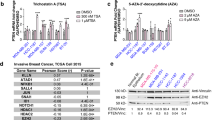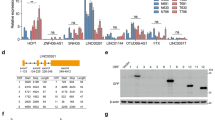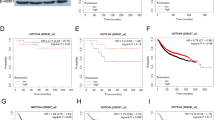Abstract
Mutation in PTEN has not yet been detected, but its function as a tumor suppressor is inactivated in many cancers. In this study we determined that, activated Notch signaling disables PTEN by phosphorylation and thereby contributes to gastric tumorigenesis. Notch inhibition by small interfering RNA or γ-secretase inhibitor (GSI) induced mitotic arrest and apoptosis in gastric cancer cells. Notch inhibition induced dephosphorylation in the C-terminal domain of PTEN, which led to PTEN nuclear localization. Overexpression of activated Notch1-induced phosphorylation of PTEN and reversed GSI-induced mitotic arrest. Dephosphorylated nuclear PTEN caused prometaphase arrest by interaction with the cyclin B1-CDK1 complex, resulting in their accumulation in the nucleus and subsequent apoptosis. We found a correlation between high expression levels of Notch1 and low survival rates and, similarly, between reduced nuclear PTEN expression and increasing the TNM classification of malignant tumours stages in malignant tissues from gastric cancer patients. The growth of Notch1-depleted gastric tumors was significantly retarded in xenografted mice, and in addition, PTEN deletion restored growth similar to control tumors. We also demonstrated that combination treatment with GSI and chemotherapeutic agents significantly reduced the orthotopically transplanted gastric tumors in mice without noticeable toxicity. Overall, our findings suggest that inhibition of Notch signaling can be employed as a PTEN activator, making it a potential target for gastric cancer therapy.
This is a preview of subscription content, access via your institution
Access options
Subscribe to this journal
Receive 50 print issues and online access
$259.00 per year
only $5.18 per issue
Buy this article
- Purchase on Springer Link
- Instant access to full article PDF
Prices may be subject to local taxes which are calculated during checkout






Similar content being viewed by others
References
Salmena L, Carracedo A, Pandolfi PP . Tenets of PTEN tumor suppression. Cell 2008; 133: 403–414.
Yin Y, Shen WH . PTEN: a new guardian of the genome. Oncogene 2008; 27: 5443–5453.
Zhang P, Chen JH, Guo XL . New insights into PTEN regulation mechanisms and its potential function in targeted therapies. Biomed Pharmacother 2012; 66: 485–490.
Wang X, Jiang X . Post-translational regulation of PTEN. Oncogene 2008; 27: 5454–5463.
Leslie N, Foti M . Non-genomic loss of PTEN function in cancer: not in my genes. Trends Pharmacol Sci 2011; 32: 131–140.
Song M, Salmena L, Pandolfi PP . The functions and regulation of the PTEN tumour suppressor. Nat Rev Mol Cell Biol 2012; 13: 283–296.
Boosani CS, Agrawal DK . PTEN modulators: a patent review. Expert Opin Ther Pat 2013; 23: 569–580.
Wen YG, Wang Q, Zhou CZ, Qiu GQ, Peng ZH, Tang HM . Mutation analysis of tumor suppressor gene PTEN in patients with gastric carcinomas and its impact on PI3K/AKT pathway. Oncol Rep 2010; 24: 89–95.
Sato K, Tamura G, Tsuchiya T, Endoh Y, Sakata K, Motoyama T et al. Analysis of genetic and epigenetic alterations of the PTEN gene in gastric cancer. Virchows Arch 2002; 440: 160–165.
Byun DS, Cho K, Ryu BK, Lee MG, Park JI, Chae KS et al. Frequent monoallelic deletion of PTEN and its reciprocal associatioin with PIK3CA amplification in gastric carcinoma. Int J Cancer 2003; 104: 318–327.
Lobry C, Oh P, Aifantis I . Oncogenic and tumor suppressor functions of Notch in cancer: it's NOTCH what you think. J Exp Med 2011; 208: 1931–1935.
Groth C, Fortini ME . Therapeutic approaches to modulating Notch signaling: current challenges and future prospects. Semin Cell Dev Biol 2012; 23: 465–472.
Palomero T, Dominguez M, Ferrando AA . The role of the PTEN/AKT pathway in NOTCH1-induced leukemia. Cell Cycle 2008; 7: 965–970.
Dreesen O, Brivanlou AH . Signaling pathways in cancer and embryonic stem cells. Stem Cell Rev 2007; 3: 7–17.
Efferson CL, Winkelmann CT, Ware C, Sullivan T, Giampaoli S, Tammam J et al. Downregulation of Notch pathway by a gamma-secretase inhibitor attenuates AKT/mammalian target of rapamycin signaling and glucose uptake in an ERBB2 transgenic breast cancer model. Cancer Res 2010; 70: 2476–2484.
Fortini ME . [gamma]-Secretase-mediated proteolysis in cell-surface-receptor signalling. Nat Rev Mol Cell Biol 2002; 3: 673–684.
Miele L . Notch signaling. Clin Cancer Res 2006; 12: 1074–1079.
Zhang Y, Frejtag W, Dai R, Mivechi NF . Heat shock factor-4 (HSF-4a) is a repressor of HSF-1 mediated transcription. J Cell Biochem 2001; 82: 692–703.
Bijur GN, Jope RS . Opposing actions of phosphatidylinositol 3-kinase and glycogen synthase kinase-3beta in the regulation of HSF-1 activity. J Neurochem 2000; 75: 2401–2408.
Ohtsu A . Chemotherapy for metastatic gastric cancer: past, present, and future. J Gastroenterol 2008; 43: 256–264.
Hartgrink HH, Jansen EPM, van Grieken NCT, van de Velde CJH . Gastric cancer. Lancet 2009; 374: 477–490.
Vazquez F, Ramaswamy S, Nakamura N, Sellers WR . Phosphorylation of the PTEN tail regulates protein stability and function. Mol Cell Biol 2000; 20: 5010–5018.
Trotman LC, Wang X, Alimonti A, Chen Z, Teruya-Feldstein J, Yang H et al. Ubiquitination regulates PTEN nuclear import and tumor suppression. Cell 2007; 128: 141–156.
Planchon SM, Waite KA, Eng C . The nuclear affairs of PTEN. J Cell Sci 2008; 121: 249–253.
Bolduc D, Rahdar M, Tu-Sekine B, Sivakumaren SC, Raben D, Amzel LM et al. Phosphorylation-mediated PTEN conformational closure and deactivation revealed with protein semisynthesis. eLife 2013; 2: e00691.
Vaisman N, Evgen'ev MB, Golubovskii MD . [Parallelism and paradoxes on viability and the life span of two loss-of-function mutations: heat shock protein transcriptional regulator hsf(1) and l(2)gl tumor suppressor in D. melanogaster]. Izvestiia Akademii nauk Seriia biologicheskaia/Rossiiskaia akademiia nauk 2012; 1: 27–34.
Wong GT, Manfra D, Poulet FM, Zhang Q, Josien H, Bara T . Chronic treatment with the gamma-secretase inhibitor LY-411,575 inhibits beta-amyloid peptide production and alters lymphopoiesis and intestinal cell differentiation. J Biol Chem 2004; 279: 12876–12882.
Kim SJ, Shin JY, Lee KD, Bae YK, Choi IJ, Park SH et al. Galectin-3 facilitates cell motility in gastric cancer by up-regulating protease-activated receptor-1 (PAR-1) and matrix metalloproteinase-1 (MMP-1). PloS One 2011; 6: e25103.
Kim SJ, Shin JY, Cheong TC, Choi IJ, Lee YS, Park SH et al. Galectin-3 germline variant at position 191 enhances nuclear accumulation and activation of beta-catenin in gastric cancer. Clin Exp Metastasis 2011; 28: 743–750.
Cheong TC, Shin JY, Chun KH . Silencing of galectin-3 changes the gene expression and augments the sensitivity of gastric cancer cells to chemotherapeutic agents. Cancer Sci 2010; 101: 94–102.
Wang YG, Kim SJ, Baek JH, Lee HW, Jeong SY, Chun KH . Galectin-3 increases the motility of mouse melanoma cells by regulating matrix metalloproteinase-1 expression. Exp Mol Med 2012; 44: 387–393.
Kim SJ, Shin JY, Lee KD, Bae YK, Sung KW, Nam SJ et al. MicroRNA let-7a suppresses breast cancer cell migration and invasion through downregulation of C-C chemokine receptor type 7. Breast Cancer Res 2012; 14: R14.
Lee EW, Kim JH, Ahn YH, Seo J, Ko A, Jeong M et al. Ubiquitination and degradation of the FADD adaptor protein regulate death receptor-mediated apoptosis and necroptosis. Nat Commun 2012; 3: 978.
Ahn YH, Yi H, Shin JY, Lee KD, Shin SP, Lee SJ et al. STAT3 silencing enhances the efficacy of the HSV.tk suicide gene in gastrointestinal cancer therapy. Clin Exp Metastasis 2012; 29: 359–369.
Kuhnert F, Kirshner JR, Thurston G . Dll4-Notch signaling as a therapeutic target in tumor angiogenesis. Vasc Cell 2011; 3: 20.
Kim SJ, Choi IJ, Cheong TC, Lee SJ, Lotan R, Park SH et al. Galectin-3 increases gastric cancer cell motility by up-regulating fascin-1 expression. Gastroenterology 2010; 138: e1031–e1032.
Kim JH, Park KW, Lee EW, Jang WS, Seo J, Shin S et al. Suppression of PPARgamma through MKRN1-mediated ubiquitination and degradation prevents adipocyte differentiation. Cell Death Differ 2013; 21: 594–603.
Kim SJ, Oh JS, Shin JY, Lee KD, Sung KW, Nam SJ et al. Development of microRNA-145 for therapeutic application in breast cancer. J Control Release 2011; 155: 427–434.
Ko A, Shin JY, Seo J, Lee KD, Lee EW, Lee MS et al. Acceleration of gastric tumorigenesis through MKRN1-mediated posttranslational regulation of p14ARF. J Natl Cancer Inst 2012; 104: 1660–1672.
Lee HW, Jang KS, Chun KH . Celastrol inhibits gastric cancer growth by induction of apoptosis and autophagy. BMB Rep 2014; 47: 697–702.
Kim SJ, Hwang JA, Ro JY, Lee YS, Chun KH . Galectin-7 is epigenetically-regulated tumor suppressor in gastric cancer. Oncotarget 2013; 4: 1461–1471.
Kim SJ, Lee HW, Gu Kang H, La SH, Choi IJ, Ro JY et al. Ablation of galectin-3 induces p27KIP1-dependent premature senescence without oncogenic stress. Cell Death Differ 2014; 21: 1769–1779.
Acknowledgements
The authors are grateful to the FACS facility staff of the National Cancer Center (NCC) in Korea for their technical support. This work was supported by the National Research Foundation of Korea (NRF) grant funded by the Korea government (MSIP) (No. NRF-2014R1A2A1A11050600), and the Basic Science Research Program through the National Research Foundation of Korea (NRF) funded by the Ministry of Education (NRF-2014R1A1A2055009).
Author information
Authors and Affiliations
Corresponding author
Ethics declarations
Competing interests
The authors declare no conflict of interest.
Additional information
Supplementary Information accompanies this paper on the Oncogene website
Supplementary information
Rights and permissions
About this article
Cite this article
Kim, SJ., Lee, HW., Baek, JH. et al. Activation of nuclear PTEN by inhibition of Notch signaling induces G2/M cell cycle arrest in gastric cancer. Oncogene 35, 251–260 (2016). https://doi.org/10.1038/onc.2015.80
Received:
Revised:
Accepted:
Published:
Issue Date:
DOI: https://doi.org/10.1038/onc.2015.80
This article is cited by
-
Histone methyltransferase SETD1A interacts with notch and promotes notch transactivation to augment ovarian cancer development
BMC Cancer (2023)
-
Ablation of the deubiquitinase USP15 ameliorates nonalcoholic fatty liver disease and nonalcoholic steatohepatitis
Experimental & Molecular Medicine (2023)
-
LncRNA HOTAIR impairs the prognosis of papillary thyroid cancer via regulating cellular malignancy and epigenetically suppressing DLX1
Cancer Cell International (2022)
-
NACK and INTEGRATOR act coordinately to activate Notch-mediated transcription in tumorigenesis
Cell Communication and Signaling (2021)
-
The TGFβ/Notch axis facilitates Müller cell-to-epithelial transition to ultimately form a chronic glial scar
Molecular Neurodegeneration (2021)



